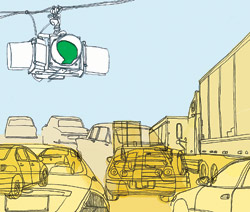 |
The day’s commute was a breeze. There was the usual backup on the Dan Ryan expressway, but no major accidents, disabled vehicles, or other incidents that can snarl traffic. As a recent morning rush hour came to a close and cars began to speed up on an open freeway, Mike Dekrell and the rest of the staff at Navteq Corp.’s Chicago traffic operations center finally got a chance to slow down. "We had a good day," said Dekrell, the jeans-and-sneakers-clad manager, who looked surprisingly alert for having been at work since 7:30 a.m. "But coming in you never know what’s going to happen."
Neither do Chicago drivers, who spend on average more than an hour each day fighting traffic. The bad news: The congestion is getting worse. The good news: Technology may one day ease the crunch. Navteq, the digital-map-making company based in Chicago, has set up a sophisticated traffic-monitoring service in River West that distributes the latest bulletins to frazzled commuters. And a research project of the University of Illinois at Chicago aims to organize the city’s first major carpool network, with riders matched not just by location but also by taste in music or movies.
Walk into Navteq’s operations center at 425 West Randolph Street, and you’re immediately struck by the array of high-tech gadgets, flat-screen televisions, computers, emergency scanners—all of which Navteq employs to gauge travel times and delays along roughly 1,800 miles of roadway in the Chicago area. They distribute the information in real time to radio and TV stations, Web sites, and even cell phones and BlackBerries. But despite all of this technology, traffic, it seems, is a beast that cannot be tamed. "There’s a lot technology can do to help us cope with traffic and reduce congestion that would otherwise occur," says Howard Hayes, a Navteq vice president. "But I’d be surprised if traffic jams became a thing of the past."
That’s because there are a lot of us on the roads. Americans love their cars, and before gas crept up toward $5 per gallon, it was relatively inexpensive to fill up and go, says Tom Vanderbilt, author of the book Traffic: Why We Drive the Way We Do (and What It Says About Us), which Knopf is publishing in July.
Here in Chicago, more than half of the city’s 1.2 million workers drive to work every day. That’s compared with the 25 percent of us who take public transportation or the paltry 5 percent who walk to their jobs, according to 2006 U.S. census data. "Door to door, driving is still the fastest way to get around, even in congested cities," says Vanderbilt. "Once you buy the car, everything is cheap. There’s no reason not to drive as much as possible."
That may be, but a group of researchers at UIC wants to bet that software could persuade the public otherwise. The college’s Intelligent Traveler Assistant (ITA) is a few years away from hitting the market, but when it does, users who download the program to their BlackBerries or iPhones will be able to access real-time traffic information, plus schedules, fares, and availability of Metra trains, buses, and rapid transit, says Peter Nelson, the engineering department dean, who is working on the project.
The system, akin to a personal travel agent, would help someone weigh all the alternatives for getting from point A to point B. For example, an office worker who needed to travel from the Sears Tower to Evanston at 5:30 p.m. could see how long it would take to drive home versus taking the el or biking. (Cost would be another factor in the comparison.) Another option will connect commuters who travel in the same direction to carpools—and even organize them by similar interests. "It’s not only about reducing travel times," says Nelson. "It’s about reducing uncertainty. I think it could help us cut down on congestion and make better use of our roadways."
The system sounds promising, even utopian. But back to the bad news: As Vanderbilt points out, traffic-reducing schemes have historically run up against resistance in the United States. Up to now, the simplest deterrent has been the most old fashioned: cash—specifically, charging drivers for using major thoroughfares during rush hours. Called congestion pricing, it is credited with reducing pollution and unclogging streets in London, Singapore, Rome, and other cities—but those are all outside of the United States. When New York’s Mayor Michael Bloomberg proposed last year that the city charge cars $8 to enter Manhattan, the idea was later shot down. Chicago’s Mayor Richard M. Daley has voiced support for a similar plan, plus increased rates for downtown parking meters and public lots during certain times of the day. Chicago Department of Transportation spokesman Brian Steele says a concrete plan is still pending.
Charging a fee "is the only pure way to deal with peak congestion," says Vanderbilt. But, he adds, Americans resist such ideas because we’ve been brought up to think of our roads as free and open to all. "It’s a giveaway, so people take advantage of it," he says. "Right now, there’s no way for people to put a value on their trip. The only value they have is time."
Illustration: Rod Hunting


